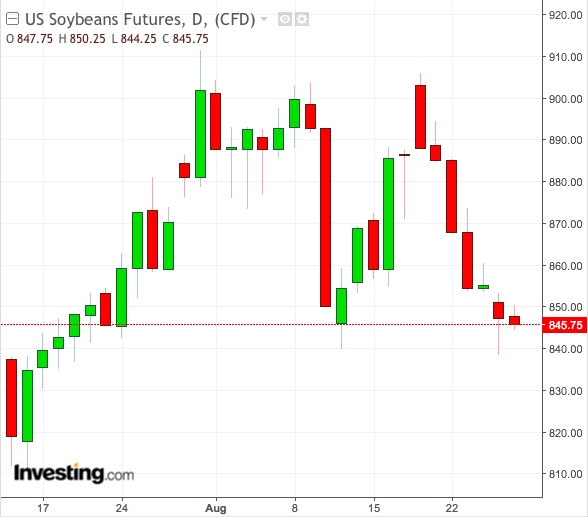Prices of agricultural commodities—from hogs to cattle to corn—jumped on yesterday's US trade agreement with Mexico that aims to rewrite NAFTA, but US commodity markets as a whole will likely meander till the United States resolves its trade wars with Canada and China.

The US-Mexico Free Trade Agreement announced on Monday essentially rebrands the North American Free Trade Area with updated deals between the two nations on digital economy, automobiles, agriculture and labor unions, but keeps the core of the old NAFTA deal—which lets American firms operate in Mexico without tariffs. The question is whether the bilateral deal can become trilateral again with Canada’s inclusion. US President Donald Trump has threatened to keep the US's northern neighbor out of the deal and hit it with auto tariffs if it doesn’t “negotiate fairly.”
From a commodities perspective, it will be advisable for Washington to seal an agreement with Ottawa, which imposed tariffs on $12.5 billion of US goods, including steel, toffee, maple syrup, coffee beans and strawberry jam a response to Trump's threats to undo NAFTA. The US, for its part, has imposed a 25 per cent tariff on steel, 20 percent on lumber and a 10 per cent tariff on aluminum coming in from Canada.
But even more important than achieving a pact with Canada will be resolving the trade war with China, which worsened last week after the two countries confirmed additional tariffs of 25 percent on each other’s imports. The trade battle began in January and escalated last month after each side approved $34 billion worth of counter tariffs.
In the latest salvo, China hit $60 billion of American goods—from liquefied natural gas to some aircraft—with levies in retaliation to US duties on $200 billion of Chinese imports. While the Chinese response hasn’t been proportional in absolute dollars to the US taxes, percentage-wise it can be alarming. China’s tariff on US pork, for instance, is as high as 70 percent.
Trump, however, said on Monday “it’s just not the right time to talk” now with China for a trade agreement.
Euphoric Ride Or More Volatility?
Without deals with Canada and China, analysts say US commodity prices may not achieve their full upside potential due to questionable demand in two of the biggest markets for American-made goods. Some think commodity markets could ride an euphoric high now that the first piece of the 3-way trade jigsaw has been put in place. Also, speculation that Trump will be determined to see through what he set out to do—ostensibly to strike the best deal for America—might keep prices buoyant over the next few days.
But others feel that unless serious intent is telegraphed soon by Ottawa and Beijing to commit to their own deals with Washington, prices could slide back by the weekend, marking the onset of greater volatility. “From our perspective as traders and such, it really provides so much uncertainty, that a lot of people are backing off from being involved because you don’t know what your gonna hear from one day to the next,” said Steve Platt, a futures strategist at Archer Financials in Chicago and active participant in commodities for over 40 years. “You get optimism one day that there’ll be a trade deal, followed immediately by pessimism the next.”
Adam Sarhan, founder and CEO of New York-based global capital markets fund 50 Park Investments, concurred. “At this juncture, the impact on US-traded commodities from this so-called US-Mexico Free Trade Agreement is negligible,” said Sarhan. “The deal itself doesn’t impact raw materials much. If it did, you’d have seen more upward movement in Monday’s markets.”

Lean hogs traded on the Chicago Mercantile Exchange were the biggest commodity gainers in the previous session, rising nearly 6 percent, after the trade deal announced on Monday potentially did away with a 20 percent Mexican tariff on US pork products.
Other major beneficiaries were CME corn, which settled up almost 3.5 percent, and live cattle, which rose nearly 2 percent. Live cattle had rallied alongside lean hogs in recent weeks as traders saw the two meats as protein alternatives. Corn is one of Mexico’s most important US imports, used as feed for cows and other livestock, and the Mexican government had been studying imposing taxes on the grain to counter steep US tariffs on Mexican steel and aluminum.
Only A Few Commodities Rallied On US-Mexico Deal
While a few commodities rallied, many had limited gains. Some even fell.

CME soybeans hit six-week lows and settled down nearly 1.0 percent on continuous pressure meted out by China’s 25 percent tax on the US soybeans. For the year, the market is down 12 percent.
“Prospects of a large crop and clouds of trade war continue to cast a huge shadow of uncertainty as to when the outlook may improve,” Dan Hueber of The Center for Agriculture in St. Charles, Illinois, wrote in a Monday note on soybeans.
Copper on the COMEX metals division of NYMEX, gained 0.2 percent. But for the year, it remains down 17 percent, with China targeting a 25 percent tariff on imports of copper ore and concentrate from the US, which shipped about 70,000 tons to the country last year.
West Texas Intermediate crude oil, traded on the New York Mercantile Exchange, climbed 0.4 percent. Brian Battle, Director at Performance Trust Capital Partners, told Bloomberg TV that he believed WTI could get to $70 per barrel with a China trade deal, though “the supply side is a little more complicated … because of Iranian oil, how the Russians are going to pump and if they can keep OPEC together.”
